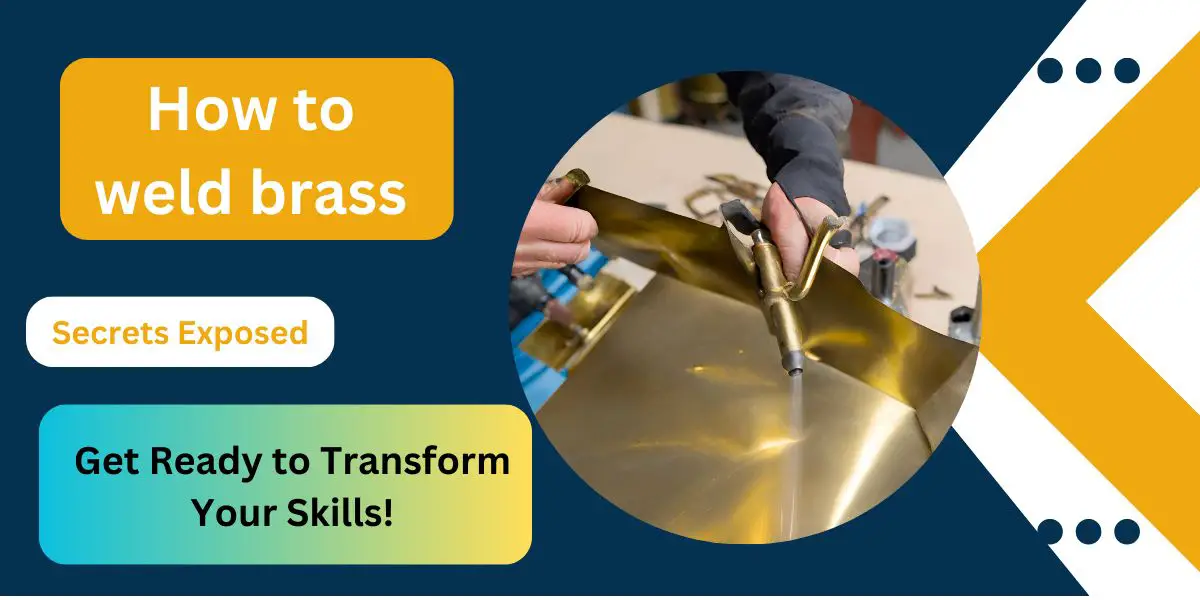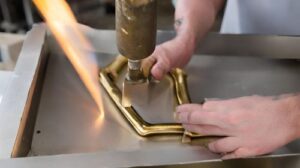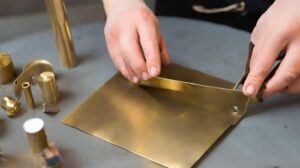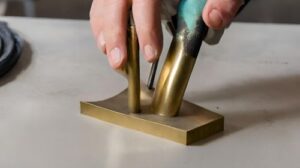Table of Contents
- 1. How to Start Welding Brass
- 2. Learning About Brass Parts
- 3. Preparation for Brass Welding
- 4. Methods for Welding Brass
- 5. Safety Measures in Brass Welding
- 6. Common Challenges in Brass Welding
- 7. Technical Aspects of Brass Welding
- Conclusion
- Mastery through Understanding
- Precision and Technique
- Safety as Priority
- Embracing Challenges, Unveiling Potential
- Diverse Applications, Endless Creativity
- The Journey Continues
- Can brass be welded using a regular welding machine?
- What safety precautions are crucial when welding brass?
- Is it possible to weld brass to other metals, like steel?
- What are the common challenges in welding brass?
- Can I weld brass without preheating?
Diving into the art of welding brass unlocks a realm of possibilities. In this guide on ‘how to weld brass,’ discover the precise techniques, safety measures, and secrets to mastering this elegant alloy. Explore the fusion of craftsmanship and metallurgical finesse, delving into the world of brass welding for both novices and seasoned artists.
1. How to Start Welding Brass
Brass, an alloy admired for its elegance and functionality, stands as a captivating medium in the realm of welding. Composed primarily of copper and zinc, this amalgam bears distinctive properties that beckon welders seeking a unique challenge.
Learning About Brass Parts
Composition of Brass
Brass typically comprises varying ratios of copper and zinc, occasionally incorporating additional elements such as lead, tin, or aluminum for specific applications. The amalgamation of these elements bestows on brass its malleability, corrosion resistance, and distinctive golden hue.
What makes brass a good metal to weld?
The welding allure of brass lies in its compatibility with various welding techniques. However, its composition demands meticulous preparation and specialized methods due to the differing melting points of copper and zinc. Understanding these nuances is crucial to achieving successful brass welds.
Why Welding with Brass?
Versatility and Aesthetic Appeal
The allure of brass extends beyond its mechanical properties. Its lustrous appearance, coupled with its resistance to corrosion, makes it a sought-after material for ornamental and functional purposes. From artistic sculptures to essential components in machinery, brass finds its way into diverse applications.
Unique Welding Challenges
Welding brass presents a nuanced challenge due to the dissimilar melting points of its components. Achieving a cohesive weld without compromising the integrity of the alloy requires finesse and expertise. This challenge, however, offers an opportunity for welders to hone their skills and explore the intricacies of metallurgy.
2. Learning About Brass Parts
Brass, renowned for its versatility and aesthetic appeal, derives its unique properties from a carefully balanced composition of metals. Exploring the components of brass illuminates its distinct characteristics and influences the welding process.
Composition of Brass
Copper and Zinc Ratio
The fundamental constituents of brass are copper and zinc, forming a wide spectrum of alloys with varying proportions. The proportions dictate brass’s mechanical properties, ranging from ductility and hardness to corrosion resistance. For instance, higher zinc content enhances hardness, while increased copper results in improved ductility.
Additional Elements in Brass
Beyond copper and zinc, brass formulations often incorporate trace elements like lead, tin, or aluminum. These additions alter specific properties, catering to diverse applications. Lead, for instance, improves machinability, while tin enhances resistance to dezincification in corrosive environments.
What makes brass a good metal to weld?
Malleability and Workability
The inherent malleability of brass allows it to be shaped, formed, and welded into intricate designs with relative ease. This characteristic, combined with its aesthetic appeal, renders brass an attractive choice for artisans and industrial craftsmen alike.
Challenges in Welding Brass
The amalgamation of copper and zinc within brass poses challenges during welding. The dissimilar melting points of these elements necessitate precise control of heat to prevent undesirable effects such as zinc evaporation or copper embrittlement. Understanding these challenges is crucial for achieving strong and durable brass welds.
This content provides a detailed overview of the components that constitute brass, highlighting how their ratios and additional elements influence the alloy’s properties and its implications for welding.
3. Preparation for Brass Welding
Welding brass demands meticulous preparation to ensure optimal results. From shaping the metal to creating an ideal workspace, each step is critical to achieving seamless brass welds.
The 5 Steps for Brass Welding Preparation
1. Cutting Brass Pieces
Accurate cutting is the foundation of successful brass welding. Precision in cutting shapes and sizes minimizes gaps during welding, ensuring a strong and seamless join. Techniques like sawing, shearing, or using specialized cutting tools cater to various shapes and sizes.
2. Bending the Brass
In certain applications, bending brass pieces to desired angles or shapes is necessary before welding. Utilizing tools like presses, benders, or rollers allows craftsmen to manipulate brass into configurations conducive to the welding process.
3. Getting Your Working Area Ready
Creating an organized and safe workspace is paramount. Ensuring proper ventilation, having fire-resistant surfaces, and employing appropriate safety gear are essential. Additionally, securing the workpiece in a stable position aids in precision and safety during welding.
4. Cleaning Your Pieces of Metal
Thoroughly cleaning brass surfaces is imperative to eliminate contaminants like oils, oxides, or residues that hinder successful welding. Techniques such as chemical cleaning, sanding, or using specialized solvents prepare the metal for optimal fusion.
5. Getting the Brass Pieces Into the Right Position
Aligning brass pieces accurately prior to welding is crucial. Fixturing tools or jigs aid in maintaining the desired position, ensuring precise alignment, and reducing the likelihood of distortion during welding.
Preparations before the Brass Welding Process
Pre-heating and Fluxing
In certain brass welding methods, pre-heating the metal and applying flux assist in controlling oxidation and ensuring better fusion. Understanding the specific requirements of the chosen welding method is pivotal for successful brass welding preparations.
This content elaborates on the crucial preparatory steps required before welding brass, emphasizing the significance of accurate cutting, workspace preparation, cleanliness, and proper alignment to achieve successful and durable brass welds.
4. Methods for Welding Brass
Welding brass demands specialized techniques that cater to its unique composition and properties. Understanding these methods empowers welders to create strong and durable brass joints.
Methodologies for Welding Brass
1. MIG Welding (Metal Inert Gas)
MIG welding, known for its simplicity and efficiency, involves feeding a consumable electrode wire through a welding gun and melting it to form the weld. Using the appropriate wire composition and shielding gas is crucial for successful MIG welding of brass, ensuring minimal oxidation and optimal fusion.
2. TIG Welding (Tungsten Inert Gas)
TIG welding employs a non-consumable tungsten electrode to create the weld. This method grants welders precise control over the heat input, allowing for intricate and high-quality brass welds. Shielding gas protection prevents oxidation during the process, ensuring clean and strong joints.
3. Flame Welding
Flame welding utilizes a flame torch to heat and melt the brass pieces, creating the weld when the molten metal solidifies. Skillful manipulation of the flame temperature and proper filler metal usage are vital for achieving robust brass welds using this method.
4. Oxy-Acetylene Welding
This welding technique combines oxygen and acetylene gases to produce a high-temperature flame used for brass welding. The precise control of the flame and proper filler metal application allows for the effective joining of brass pieces.
5. Electron Beam Brass Welding
Employing an electron beam to melt and fuse brass components, this advanced welding method offers precise control and high-speed welding, resulting in clean and strong brass joints.
Common Techniques When Welding Brass to Brass
-
MIG Welding Brass
-
TIG Welding Brass
-
Flame Welding Brass
-
Oxy-Acetylene Welding Brass
-
Electron Beam Brass Welding
Each technique demands a distinct skill set and understanding of brass’s properties. The choice of method depends on factors like joint complexity, desired aesthetics, and the welder’s proficiency.
This content provides an in-depth exploration of various methods used in welding brass, highlighting their unique processes and requirements and the importance of choosing the right technique for different applications.
5. Safety Measures in Brass Welding
Welding brass demands stringent safety protocols to ensure the well-being of the welder and the integrity of the final weld. Implementing comprehensive safety measures mitigates the risks associated with the welding process.
Safety Precautions and Tips When Welding Brass
1. Ventilation and Air Quality
Proper ventilation is critical in welding operations to remove fumes and gases produced during brass welding. Adequate airflow and the use of exhaust systems or fans help maintain breathable air quality.
2. Personal Protective Equipment (PPE)
Welders must don appropriate PPE, including welding helmets with proper shading for eye protection, flame-resistant clothing, gloves, and closed-toe shoes to safeguard against heat, sparks, and potential exposure to UV radiation.
3. Fire Safety
Establishing a fire-safe workspace is imperative. Having fire extinguishers, fire blankets, and clear evacuation routes minimizes the risk of fire accidents. Fire-resistant surfaces and materials further enhance safety.
4. Handling and Storage of Gases
Prudent handling, storage, and monitoring of welding gases like acetylene and oxygen prevent potential hazards. Storing gases in well-ventilated areas and adhering to safety guidelines for their usage is paramount.
5. Electrical Safety
Ensuring electrical safety by inspecting welding equipment, maintaining proper grounding, and avoiding contact with live electrical components mitigate the risk of electrical hazards.
Safety Equipment in Brass Welding
-
Welding Welding Helmets and Eye Protection
-
Flame-Resistant Clothing and Gloves
-
Ventilation Systems and Exhaust Fans
-
Fire Extinguishers and Fire Blankets
-
Gas Monitoring and Handling Equipment
This content emphasizes the critical importance of safety measures in brass welding, detailing specific precautions, safety equipment, and protocols that ensure a secure working environment for welders and mitigate potential hazards associated with the welding process.
6. Common Challenges in Brass Welding
Welding brass, despite its versatility, presents unique challenges attributed to its composition and properties. Understanding these challenges is pivotal in overcoming them and achieving successful brass welds.
Dissimilar Melting Points
Brass, being an alloy of copper and zinc, possesses differing melting points for each constituent metal. This discrepancy requires precise control of heat during welding to prevent issues such as zinc evaporation or copper embrittlement, which can compromise the integrity of the weld.
Oxidation and Contamination
Brass readily forms oxide layers when exposed to air. During welding, these oxides hinder proper fusion, leading to weak or flawed welds. Additionally, contamination from oils, residues, or impurities on the metal surfaces can adversely affect weld quality.
Metal Flow and Distortion
The difference in thermal conductivity between copper and zinc in brass can result in unequal metal flow during welding. This uneven flow may cause distortion or warping of the welded joint, affecting its appearance and structural integrity.
Filler Metal Selection
Choosing the appropriate filler metal for brass welding is crucial. Mismatched or improper filler metals can lead to weak welds, increased porosity, or metallurgical incompatibility, compromising the durability of the joint.
Overheating and Cracking
Excessive heat input or prolonged exposure to high temperatures can cause the brass to overheat and crack, particularly in thin or intricate welds. Maintaining optimal heat control is essential to prevent metallurgical changes that result in cracking.
This content outlines the common challenges faced during brass welding, emphasizing the importance of understanding these challenges and implementing appropriate strategies to ensure successful and durable welds.
7. Technical Aspects of Brass Welding
Delving into the technical intricacies of brass welding unveils the fundamental elements and procedures essential for achieving proficient and enduring welds.
Welding Joints in Brass Welding
-
Butt Joints
Commonly used in brass welding, butt joints involve joining two brass pieces aligned in the same plane. Proper edge preparation, fit-up, and welding technique are crucial for robust butt joints.
-
Lap Joints
Lap joints, where one brass piece overlaps the other, demand precision in alignment and welding to ensure strong and leak-free connections. Controlling heat input is critical to prevent distortion in lap joints.
Features of Brass Welds
-
Penetration and Fusion
Achieving adequate penetration and fusion without excessive heat input is vital for creating sound brass welds. Proper adjustment of welding parameters and techniques ensures thorough fusion between brass components.
-
Strength and Durability
A well-executed brass weld exhibits strength and durability akin to the base material. Optimal welding practices, including filler metal selection and heat control, contribute to the mechanical integrity of the joint.
Advantages of Brass Welding
-
Corrosion Resistance
Brass welds inherit the corrosion-resistant properties of the alloy, making them suitable for applications in various environments, including marine and chemical settings.
-
Aesthetic Appeal
Properly executed brass welds retain the aesthetic charm of the alloy, allowing for visually appealing finishes in both functional and decorative applications.
Equipment in Brass Welding
-
Welding Machines and Power Sources
-
Welding Electrodes or Filler Metals
-
Welding Torches and Accessories
-
Fixturing Tools and Clamps
Shielding Gases in Brass Welding
Utilizing appropriate shielding gases, such as argon or helium, protects the molten brass from atmospheric contamination during welding, ensuring clean and high-quality welds.
Application of Brass Welding
-
Artistic Creations
-
Fabrication of Industrial Components
-
Plumbing and Pipework
-
Electrical Connectors and Terminals
This content elaborates on the technical aspects of brass welding, encompassing welding joint types, features of welds, advantages, equipment used, the significance of shielding gases, and applications, offering a comprehensive understanding of the technical intricacies involved in welding brass.
Conclusion
In conclusion, yes, you can weld brass using methods like brazing and TIG welding. Both processes offer reliable and robust joints for brass components. However, soldering is also an option for less demanding applications.
Brass welding, a fusion of artistry and technical expertise, unveils a world of possibilities where craftsmanship meets metallurgical precision. Through meticulous preparation, adept handling of challenges, and mastery of techniques, the journey of welding brass unfolds with both challenges and rewards.
Mastery through Understanding
Understanding the composition of brass, its unique properties, and the nuances of its welding process forms the bedrock for successful brass fabrication. Each element, from the ratio of copper and zinc to the additional components, contributes to the alloy’s characteristics, influencing weldability and application.
Precision and Technique
The artistry of brass welding demands precision in every step. From the careful preparation of metal surfaces to the selection of appropriate welding methods and the execution of flawless welds, attention to detail is paramount. Each technique – be it MIG, TIG, flame, oxy-acetylene, or electron beam welding – offers its canvas for craftsmen to create seamless brass joints.
Safety as Priority
Amidst the craftsmanship, safety stands tall as an unwavering priority. Comprehensive safety measures, from proper ventilation and personal protective equipment to prudent handling of gases and fire safety, ensure a secure working environment for welders.
Embracing Challenges, Unveiling Potential
Challenges inherent in brass welding – dissimilar melting points, oxidation, metal flow, filler metal selection, and potential cracking – are hurdles that, once understood and managed, pave the way for mastering this art. Overcoming these challenges unveils the potential of brass welding, enabling the creation of enduring and visually captivating welds.
Diverse Applications, Endless Creativity
The applications of brass welding are as diverse as its properties. From artistic creations to critical industrial components, plumbing, electrical connectors, and beyond, the versatility of brass welds finds its place in myriad industries and artistic endeavors, combining functionality with aesthetics.
The Journey Continues
As this exploration concludes, the journey of brass welding continues to unfold. Armed with knowledge, skill, and an appreciation for the nuances of brass, welders embark on a path where craftsmanship merges with metallurgical finesse, shaping the shimmering allure of brass into enduring and captivating creations.
So, go ahead and explore the world of welding brass, and let your creativity shine with this beautiful and versatile metal alloy!
Can brass be welded using a regular welding machine?
Yes, brass can be welded using various welding machines like TIG, MIG, and oxy-acetylene with specific techniques and considerations.
What safety precautions are crucial when welding brass?
Proper ventilation, protective gear (welding helmet, gloves, etc.), and fire safety measures are essential due to the heat and fumes generated during the process.
Is it possible to weld brass to other metals, like steel?
Yes, it’s feasible, but it requires specialized techniques and often involves using intermediate materials or fillers compatible with both metals.
What are the common challenges in welding brass?
Dissimilar melting points of copper and zinc in brass, oxidation, metal flow control, and filler metal selection are common challenges.
Can I weld brass without preheating?
It depends on the method. Some techniques, like TIG welding, might not require preheating, while others, like flame welding, may benefit from preheating to ensure better fusion.




